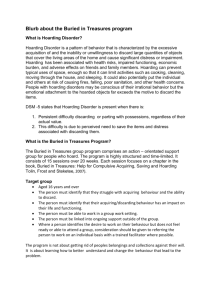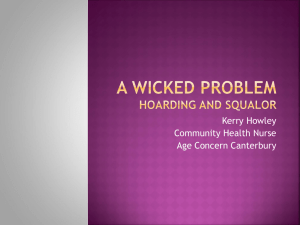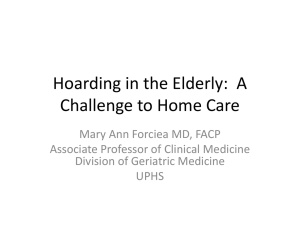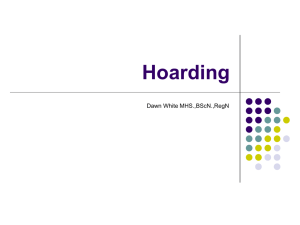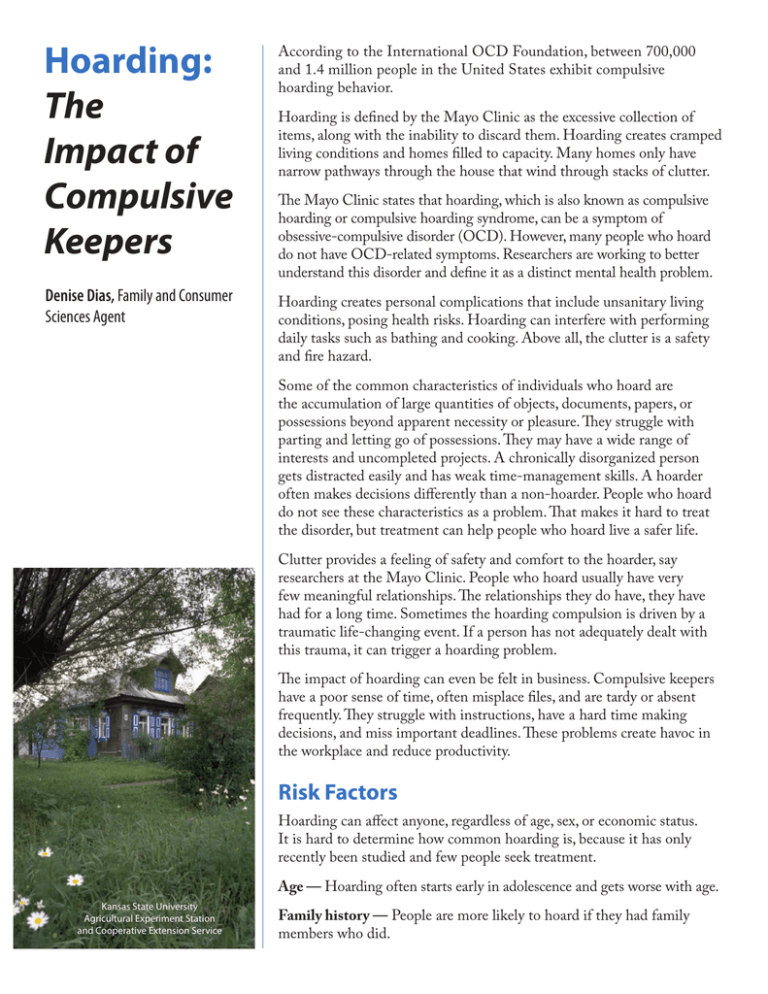
Hoarding:
The
Impact of
Compulsive
Keepers
According to the International OCD Foundation, between 700,000
and 1.4 million people in the United States exhibit compulsive
hoarding behavior.
Denise Dias, Family and Consumer
Sciences Agent
Hoarding creates personal complications that include unsanitary living
conditions, posing health risks. Hoarding can interfere with performing
daily tasks such as bathing and cooking. Above all, the clutter is a safety
and fire hazard.
Hoarding is defined by the Mayo Clinic as the excessive collection of
items, along with the inability to discard them. Hoarding creates cramped
living conditions and homes filled to capacity. Many homes only have
narrow pathways through the house that wind through stacks of clutter.
The Mayo Clinic states that hoarding, which is also known as compulsive
hoarding or compulsive hoarding syndrome, can be a symptom of
obsessive-compulsive disorder (OCD). However, many people who hoard
do not have OCD-related symptoms. Researchers are working to better
understand this disorder and define it as a distinct mental health problem.
Some of the common characteristics of individuals who hoard are
the accumulation of large quantities of objects, documents, papers, or
possessions beyond apparent necessity or pleasure. They struggle with
parting and letting go of possessions. They may have a wide range of
interests and uncompleted projects. A chronically disorganized person
gets distracted easily and has weak time-management skills. A hoarder
often makes decisions differently than a non-hoarder. People who hoard
do not see these characteristics as a problem. That makes it hard to treat
the disorder, but treatment can help people who hoard live a safer life.
Clutter provides a feeling of safety and comfort to the hoarder, say
researchers at the Mayo Clinic. People who hoard usually have very
few meaningful relationships. The relationships they do have, they have
had for a long time. Sometimes the hoarding compulsion is driven by a
traumatic life-changing event. If a person has not adequately dealt with
this trauma, it can trigger a hoarding problem.
The impact of hoarding can even be felt in business. Compulsive keepers
have a poor sense of time, often misplace files, and are tardy or absent
frequently. They struggle with instructions, have a hard time making
decisions, and miss important deadlines. These problems create havoc in
the workplace and reduce productivity.
Risk Factors
Hoarding can affect anyone, regardless of age, sex, or economic status.
It is hard to determine how common hoarding is, because it has only
recently been studied and few people seek treatment.
Kansas State University
Agricultural Experiment Station
and Cooperative Extension Service
Age — Hoarding often starts early in adolescence and gets worse with age.
Family history — People are more likely to hoard if they had family
members who did.
Stressful life events — Some people start to hoard after experiencing a
stressful life event they find difficult to cope with, such as the death of a
loved one, divorce, eviction, or losing possessions in a fire.
Social isolation — Often people who hoard are withdrawn from society
because they are isolated or lonely.
Perfectionism — People who compulsively hoard are perfectionists.
They worry about making the right decision about what should be done
with each possession. The process of trying to decide what to do with
possessions creates distress, so they avoid making any decision and keep
everything instead.
Animal Hoarding
People also sometimes hoard animals. Often animals are kept indoors and
hidden from public view. If there are too many animals, the person cannot
take care of them properly, and a veterinarian or neighbor may be the first
to see the signs of a problem. It is not uncommon to find both humans
and animals in unsanitary and unsafe conditions.
Solutions
Neighbors and family members can be part of the solution. According
to the Mayo Clinic, hoarding can lead to isolation and loneliness, which
in turn can lead to more hoarding. As with the saying “it takes a whole
village to raise a child,” it takes a community to help a hoarder come
forward and find the help necessary to overcome this problem. Hoarding
problems will only continue to get worse unless there is an appropriate
intervention. The worst thing to do is to go into the hoarder’s home and
clean it up. The hoarder will just revert to old habits or even worse. Social
supports need to be in place to help a hoarder deal with the problem.
If you identify someone who is a hoarder, be patient. This situation did
not happen overnight. It takes time to learn new skills and strategies to
cope with a hoarding disorder. Effective treatment of hoarding can take
up to a year, not to mention the long-term support needed to keep a
hoarder from falling back into old habits.
Living with or working with someone who is chronically disorganized
can be a challenge. First and foremost, keep lines of communication open.
If you get angry with a hoarder, be direct and emphasize he or she is more
important to you than the clutter.
Coaching is an important skill to have when dealing with people who
hoard. Often family members do not make good coaches. Here are some
coaching skills to consider:
• Listen without making a judgment.
• Treat people who hoard as you would like to be treated, with respect
and dignity.
2
Resources
For more information:
Hoarding Coalition, Wichita/Sedgwick
County, www.sedgwickcounty.org/hoarding
Mayo Clinic / Health Information/Diseases /
Symptoms, www.mayoclinic.com/health/
hoarding/DS00966
Institute for Challenging Disorganization,
www.challengingdisorganization.org
International OCD Foundation Hoarding
Center, www.ocfoundation.org/hoarding/
Examples of potential resource groups and
agencies that might be involved:
• Professional Organizers Association,
www.napo.net/
• Area Agencies on Aging and Senior Centers
• Adult Protective Services – SRS
• Animal Services and Shelters
• Fire Department
• Housing and Community Services
• Police Department
• Code Enforcement
• Environmental Resources
• Focus on the person’s good qualities, not the mess. Find ways to draw
out his or her best assets and not focus on faults.
• Recognize small steps of progress in eliminating clutter.
• Remember that good coaches help shape the decision so it’s easier to
make; they do not make the decision for the person.
It may be hard to reserve judgment, but seek to understand first. When
listening to the description of the problem by someone who is hoarding,
carefully reflect on what is said. Then, look around the community for
local groups or agencies to help support and address the person’s problem.
Everyone who hoards wants to feel accepted by family and others in
the community. There is an increasing stigma on people who hoard.
Communities and family members need to work together to create
support systems for these individuals.
Prevention and Treatment
Since little is known about what causes hoarding, no one knows how to
prevent it.
According to the Mayo Clinic, you should seek help from a doctor if
clutter and difficulty in discarding things is a problem. This condition
usually surfaces in the teenage years. As an affected person grows older,
he or she typically starts to acquire things for which there is no need or
space. By middle-age, when the condition is usually diagnosed, symptoms
are often severe and difficult to treat.
If you or a loved one has symptoms of hoarding, talk with a doctor or
mental health provider. Some communities have agencies that can help
you locate resources in your area.
It may be difficult to do, but contacting local authorities — such as police,
fire, public health, or animal welfare agencies — may be the best choice,
especially when health or safety is at risk.
Are You Chronically Disorganized?
Here is a questionnaire to help you determine if you are chronically disorganized.
Answer the following questions yes or no:
1. Has disorganization been a factor in your life for many years?
2. Does your level of disorganization interfere with the quality of daily life or
negatively affect your relations with others?
3. Has disorganization persisted despite self-help attempts to get organized?
4. Do you own at least one organization book?
5. Do you save many articles, newspapers, or books you’ve read?
6. Do you suffer from “fear of filing”?
7. Do you feel every paper must be kept in sight or you’ll never find it again?
8. Do you lose or misplace papers and items despite keeping them out?
9. Does your filing system cause difficulty in retrieval?
10. Does it take you more than 3 minutes to find most papers in your office?
3
11. Do you like to collect things?
12. Are you a shopaholic?
13. Do you accumulate possessions beyond apparent usefulness or pleasure?
14. Does your disorganization cause you embarrassment or humiliation?
15. Are your desk, floor, and/or countertops covered in papers?
16. Did you feel deprived as a child, either emotionally or materially?
17. Is it difficult for you to part with things even though they have outlived their
usefulness?
18. Do you consider yourself a pack rat?
19. Do you have a wide range of interests and several uncompleted tasks and
projects?
20. Do you find it difficult to stay focused or are you easily distracted?
Author
Denise Dias, Family and Consumer Sciences
Agent, K-State Research and Extension –
Sedgwick County
21. Do you tend to lose track of time?
If you answered “yes” to questions 1, 2, 3, and some of the other questions, you could
be chronically disorganized. Chronic disorganization is found at the extreme end of the
continuum, differing from severely disorganized. Chronic disorganization is marked by
its longevity, interference with quality of life, and resistance to self-help efforts.
If you answered “yes” to several other questions, don’t panic. There are solutions.
There are many types and levels of disorganization relating to the areas of paper,
time, and clutter management. Anyone can be taught to increase his or her level
of organization. It is never hopeless. Professional organizers can help you succeed
where self-help falls short, while saving you countless hours of effort trying to
discover the most effective solutions for yourself.
This quiz is from the Institute for Challenging Disorganization,
www.challengingdisorganization.org, ICD Fact Sheet 001, Diane Hatcher, author and
professional organizer. Find it at www.challengingdisorganization.org/content/factsheets-public-0
Reviewers
Carol Young, Family Financial Management
Specialist, K-State Research and Extension
Sarah Taylor, Family and Consumer Sciences
Agent, K-State Research and Extension –
Sedgwick County
Brand names appearing in this publication are for product identification purposes only.
No endorsement is intended, nor is criticism implied of similar products not mentioned.
Publications from Kansas State University are available at: www.ksre.ksu.edu
Publications are reviewed or revised annually by appropriate faculty to reflect current research and practice.
Date shown is that of publication or last revision. Contents of this publication may be freely reproduced for
educational purposes. All other rights reserved.
In each case, credit Denise Dias, Hoarding: The Impact of Compulsive Keepers, Fact Sheet,
Kansas State University, August 2011.
Kansas State University Agricultural Experiment Station and Cooperative Extension Service
MF2990
August 2011
K-State Research and Extension is an equal opportunity provider and employer. Issued in furtherance of Cooperative Extension Work, Acts of May 8 and June 30, 1914,
as amended. Kansas State University, County Extension Councils, Extension Districts, and United States Department of Agriculture Cooperating, Gary Pierzynski, Interim
Director.

